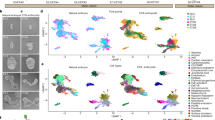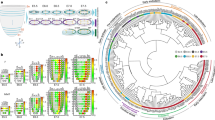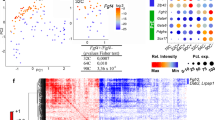Abstract
Anterior–posterior polarity of the mouse embryo has been thought to be established when distal visceral endoderm (DVE) at embryonic day (E) 5.5 migrates toward the future anterior side to form anterior visceral endoderm (AVE). Lefty1, a marker of DVE and AVE, is asymmetrically expressed in implanting mouse embryos. We now show that Lefty1 is expressed first in a subset of epiblast progenitor cells and then in a subset of primitive endoderm progenitors. Genetic fate mapping indicated that the latter cells are destined to become DVE. In contrast to the accepted notion, however, AVE is not derived from DVE but is newly formed after E5.5 from Lefty1− visceral endoderm cells that move to the distal tip. Concomitant with DVE migration, all visceral endoderm cells in the embryonic region undergo global movement. In embryos subjected to genetic ablation of Lefty1-expressing DVE cells, AVE was formed de novo but the visceral endoderm including the newly formed AVE failed to migrate, indicating that DVE guides the migration of AVE by initiating the global movement of visceral endoderm cells. Future anterior–posterior polarity is thus already determined by Lefty1+ blastomeres in the implanting blastocyst.
This is a preview of subscription content, access via your institution
Access options
Subscribe to this journal
Receive 12 print issues and online access
$209.00 per year
only $17.42 per issue
Buy this article
- Purchase on Springer Link
- Instant access to full article PDF
Prices may be subject to local taxes which are calculated during checkout








Similar content being viewed by others
References
Huynh, J. R. & St Johnston, D. The origin of asymmetry: early polarisation of the Drosophila germline cyst and oocyte. Curr. Biol. 14, R438–R449 (2004).
Beddington, R. S. & Robertson, E. J. Anterior patterning in mouse. Trends Genet. 14, 277–284 (1998).
Beddington, R. S. & Robertson, E. J. Axis development and early asymmetry in mammals. Cell 96, 195–209 (1999).
Rossant, J. & Tam, P. P. Blastocyst lineage formation, early embryonic asymmetries and axis patterning in the mouse. Development 136, 701–713 (2009).
Takaoka, K. et al. The mouse embryo autonomously acquires anterior–posterior polarity at implantation. Dev. Cell 10, 451–459 (2006).
Chazaud, C. & Rossant, J. Disruption of early proximodistal patterning and AVE formation in Apc mutants. Development 133, 3379–3387 (2006).
Torres-Padilla, M. E. et al. The anterior visceral endoderm of the mouse embryo is established from both preimplantation precursor cells and by de novo gene expression after implantation. Dev. Biol. 309, 97–112 (2007).
Rossant, J., Chazaud, C. & Yamanaka, Y. Lineage allocation and asymmetries in the early mouse embryo. Phil. Trans. R. Soc. Lond. B Biol. Sci. 358, 1341–1348 (2003) (discussion 1349).
Chazaud, C., Yamanaka, Y., Pawson, T. & Rossant, J. Early lineage segregation between epiblast and primitive endoderm in mouse blastocysts through the Grb2–MAPK pathway. Dev. Cell 10, 615–624 (2006).
Plusa, B., Piliszek, A., Frankenberg, S., Artus, J. & Hadjantonakis, A. K. Distinct sequential cell behaviours direct primitive endoderm formation in the mouse blastocyst. Development 135, 3081–3091 (2008).
Yamanaka, Y., Lanner, F. & Rossant, J. FGF signal-dependent segregation of primitive endoderm and epiblast in the mouse blastocyst. Development 137, 715–724 (2010).
Feil, R., Wagner, J., Metzger, D. & Chambon, P. Regulation of Cre recombinase activity by mutated estrogen receptor ligand-binding domains. Biochem. Biophys. Res. Commun. 237, 752–757 (1997).
Soriano, P. Generalized lacZ expression with the ROSA26 Cre reporter strain. Nat. Genet. 21, 70–71 (1999).
Smith, L. J. Embryonic axis orientation in the mouse and its correlation with blastocyst relationships to the uterus. II. Relationships from 4 1/4 to 9 1/2 days. J. Embryol. Exp. Morphol. 89, 15–35 (1985).
Gardner, R. L., Meredith, M. R. & Altman, D. G. Is the anterior–posterior axis of the fetus specified before implantation in the mouse? J. Exp. Zool. 264, 437–443 (1992).
Ferrer-Vaquer, A. et al. A sensitive and bright single-cell resolution live imaging reporter of Wnt/ss-catenin signaling in the mouse. BMC Dev. Biol. 10, 121 (2010).
Yamamoto, M. et al. Nodal antagonists regulate formation of the anteroposterior axis of the mouse embryo. Nature 428, 387–392 (2004).
Perea-Gomez, A. et al. Nodal antagonists in the anterior visceral endoderm prevent the formation of multiple primitive streaks. Dev. Cell 3, 745–756 (2002).
Rivera-Perez, J. A., Mager, J. & Magnuson, T. Dynamic morphogenetic events characterize the mouse visceral endoderm. Dev. Biol. 261, 470–487 (2003).
Migeotte, I., Omelchenko, T., Hall, A. & Anderson, K. V. Rac1-dependent collective cell migration is required for specification of the anterior–posterior body axis of the mouse. PLoS Biol. 8, e1000442 (2010).
Weber, R. J., Pedersen, R. A., Wianny, F., Evans, M. J. & Zernicka-Goetz, M. Polarity of the mouse embryo is anticipated before implantation. Development 126, 5591–5598 (1999).
Perea-Gomez, A. et al. Otx2 is required for visceral endoderm movement and for the restriction of posterior signals in the epiblast of the mouse embryo. Development 128, 753–765 (2001).
Ivanova, A. et al. In vivo genetic ablation by Cre-mediated expression of diphtheria toxin fragment A. Genesis 43, 129–135 (2005).
Miura, S. & Mishina, Y. The DVE changes distal epiblast fate from definitive endoderm to neurectoderm by antagonizing nodal signaling. Dev. Dyn. 236, 1602–1610 (2007).
Chu, J. & Shen, M. M. Functional redundancy of EGF-CFC genes in epiblast and extraembryonic patterning during early mouse embryogenesis. Dev. Biol. 342, 63–73 (2010).
Srinivas, S., Rodriguez, T., Clements, M., Smith, J. C. & Beddington, R. S. Active cell migration drives the unilateral movements of the anterior visceral endoderm. Development 131, 1157–1164 (2004).
Thomas, P. & Beddington, R. Anterior primitive endoderm may be responsible for patterning the anterior neural plate in the mouse embryo. Curr. Biol. 6, 1487–1496 (1996).
Kimura, C., Shen, M. M., Takeda, N., Aizawa, S. & Matsuo, I. Complementary functions of Otx2 and Cripto in initial patterning of mouse epiblast. Dev. Biol. 235, 12–32 (2001).
Beppu, H. et al. BMP type II receptor is required for gastrulation and early development of mouse embryos. Dev. Biol. 221, 249–258 (2000).
Rodriguez, T. A., Srinivas, S., Clements, M. P., Smith, J. C. & Beddington, R. S. Induction and migration of the anterior visceral endoderm is regulated by the extra-embryonic ectoderm. Development 132, 2513–2520 (2005).
Yamamoto, M. et al. Antagonism between Smad1 and Smad2 signaling determines the site of distal visceral endoderm formation in the mouse embryo. J. Cell Biol. 184, 323–334 (2009).
Mesnard, D., Filipe, M., Belo, J. A. & Zernicka-Goetz, M. The anterior–posterior axis emerges respecting the morphology of the mouse embryo that changes and aligns with the uterus before gastrulation. Curr. Biol. 14, 184–196 (2004).
Nagai, T. et al. A variant of yellow fluorescent protein with fast and efficient maturation for cell-biological applications. Nat. Biotechnol. 20, 87–90 (2002).
Shaner, N. C. et al. Improved monomeric red, orange and yellow fluorescent proteins derived from Discosoma sp. red fluorescent protein. Nat. Biotechnol. 22, 1567–1572 (2004).
Copeland, N. G., Jenkins, N. A. & Court, D. L. Recombineering: a powerful new tool for mouse functional genomics. Nat. Rev. Genet. 2, 769–779 (2001).
Gong, S. et al. A gene expression atlas of the central nervous system based on bacterial artificial chromosomes. Nature 425, 917–925 (2003).
Saijoh, Y. et al. Distinct transcriptional regulatory mechanisms underlie left–right asymmetric expression of lefty-1 and lefty-2. Genes Dev. 13, 259–269 (1999).
Acknowledgements
We thank A. Fukumoto, H. Nishimura, K. Miyama, Y. Hamada, S. Ohishi, and K. Yamashita for technical assistance, A. Miyawaki for the mVenus complementary DNA and R. Tsien for tdTomato and Cherry cDNAs. This work was supported by a grant from CREST (Core Research for Evolutional Science and Technology) of the Japan Science and Technology Corporation as well as by a Grant-in-Aid from the Ministry of Education, Culture, Sports, Science, and Technology of Japan. K.T. was supported by a fellowship from the Japan Society for the Promotion of Science for Japanese Junior Scientists and Grant-in-Aid for Scientific Research on Innovative Areas.
Author information
Authors and Affiliations
Contributions
Project planning was carried out mainly by K.T. and partly by M.Y. and H.H.; all experiments involving mouse embryos were carried out by K.T.; the manuscript was written by K.T. and H.H.
Corresponding authors
Ethics declarations
Competing interests
The authors declare no competing financial interests.
Supplementary information
Supplementary Information
Supplementary Information (PDF 3306 kb)
Supplementary Information
Supplementary Movie 1 (MOV 164 kb)
Supplementary Information
Supplementary Movie 2 (MOV 153 kb)
Supplementary Information
Supplementary Movie 3 (MOV 194 kb)
Supplementary Information
Supplementary Movie 4 (MOV 663 kb)
Supplementary Information
Supplementary Movie 5 (MOV 516 kb)
Supplementary Information
Supplementary Movie 6 (MOV 525 kb)
Supplementary Information
Supplementary Movie 7 (MOV 496 kb)
Supplementary Information
Supplementary Movie 8 (MOV 703 kb)
Supplementary Information
Supplementary Movie 9 (MOV 727 kb)
Supplementary Information
Supplementary Movie 10 (MOV 614 kb)
Supplementary Information
Supplementary Movie 11 (MOV 721 kb)
Supplementary Information
Supplementary Movie 12 (MOV 614 kb)
Supplementary Information
Supplementary Movie 13 (MOV 742 kb)
Rights and permissions
About this article
Cite this article
Takaoka, K., Yamamoto, M. & Hamada, H. Origin and role of distal visceral endoderm, a group of cells that determines anterior–posterior polarity of the mouse embryo. Nat Cell Biol 13, 743–752 (2011). https://doi.org/10.1038/ncb2251
Received:
Accepted:
Published:
Issue Date:
DOI: https://doi.org/10.1038/ncb2251
This article is cited by
-
Self-patterning of human stem cells into post-implantation lineages
Nature (2023)
-
Vacuolar-type proton ATPase is required for maintenance of apicobasal polarity of embryonic visceral endoderm
Scientific Reports (2021)
-
Origin and function of the yolk sac in primate embryogenesis
Nature Communications (2020)
-
Molecular Characteristics, Phylogeny and Expression Profile of the PTEN Gene in Goats
Biochemical Genetics (2020)
-
Vertebrate cranial mesoderm: developmental trajectory and evolutionary origin
Cellular and Molecular Life Sciences (2020)



